Contents
A bird of the upland fringe
Black grouse are birds of edge habitats. They like, in particular, the transition zone between northern forest and moorland heath. In this habitat they can shelter in the forest in the worst winter weather, feed on tree buds in spring and, in summer, they can nest on open ground and forage with their chicks among the grasses and heathland shrubs.
The black grouse has a spectacular communal breeding system. At dawn in spring, males (blackcock) congregate on traditional display grounds (referred to as a lek). Here they stake out small patches of ground on to which they entice females for mating.
Females (greyhens) are cryptically coloured in mottle brown and lay their eggs in thick ground vegetation within a kilometre or so of the lek. After hatching they take their broods to feed among the tall grasses, rushes and heathland shrubs where they feed first on insects then buds, flowers and seeds.
| Black grouse nutrition |
The staple foods of black grouse are heather and bilberry, but black grouse like buds, leaves, flowers, seeds, stems and even the spore capsules of mosses and twigs of several trees.
|
| Spring |
Summer |
Autumn and winter |
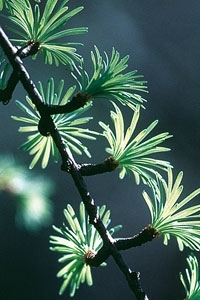
Black grouse favour cotton grass flower buds and larch buds. Other foods are herbs such as buttercup, sorrel and marigold found in unimproved pastures and hay meadows. |
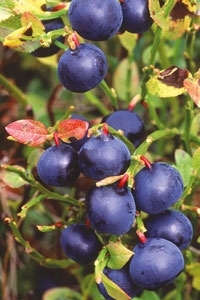
In the summer, black grouse
go for flowers, fruits and seeds, rather than leaves. They like
the seeds of grasses, rushes
and sedges, and the flowers of herbs in wet bog flushes, herb-rich rough pastures and
hay meadows. Bilberry and cowberry fruits are eaten by adults, but young chicks need insects to begin with. |
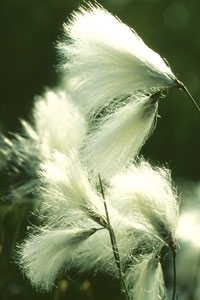
In autumn the berries of bilberry, cowberry, crowberry and rowan, and seeds of grasses and heath rush are important. After snow fall, black grouse take to the trees, eating the buds and catkins of birch and hazel, and what’s left of the berries. |
Most black grouse chicks hatch in mid-June and they remain as a family covey until September. Young males tend to reside close to the home lek whereas females often disperse several kilometres to other areas of suitable habitat where there are other populations of black grouse.
The decline of black grouse
|
Black grouse habitat and distribution
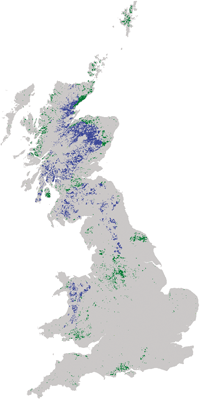
Suitable habitat (based on analysis of the Centre of Ecology and Hydrology land cover map) is shown as either blue, where black grouse are currently present, or green, where they are absent. Based on The New Atlas of Breeding Birds in Britain and Ireland: 1998-1991 and recent information.
|
The last estimate of black grouse numbers in Britain was 5,000 displaying males in 2005, with the population centred on a few key upland areas of Scotland, northern England and Wales. 150 years ago black grouse were more numerous and widespread and they could be found on many heaths of southern and eastern England. The decline and contraction of range seems to have begun about a century ago following gradual improvements in farming.
Most worrying is that in the late 1990s the black grouse was declining at a rate of some 8-10% per year with a geographical range that was continuing to contract.
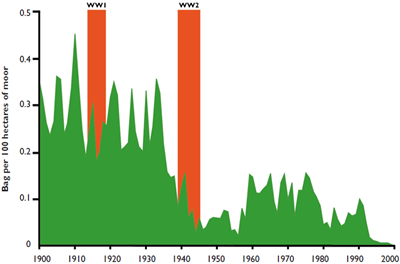
Trend in the numbers of black grouse shot from British estates during the 20th Century. Data from the National Gamebag Census key data set of 84 estates that have 80% complete records since 1900. Some 30+ of these places were shooting black grouse between the wars.
Today’s continuing loss seems to stem from the following:
- Loss of habitat mosaic. Land-use used to be mixed. Black grouse favour a patchwork quilt of farmland adjacent to moor and forest, and they need a sweep of suitable countryside to sustain their population. Contiguous areas have been broken up by block forestry and intensive farming.
- Over-grazing. High densities of sheep and red deer eat out ground cover, thereby reducing the abundance of caterpillars that grouse chicks need.
- Changes in forestry. Black grouse like the ground cover in young plantations, but as these develop into solid conifer thickets they tend to leave. Forest edge used to melt into heathland through a transition of scattered trees; today’s forests are hard edged.
- Increased mortality. Because they are now more common, crows foxes, stoats and some birds of prey cause a high annual loss. In addition, forest deer fences kill many birds.